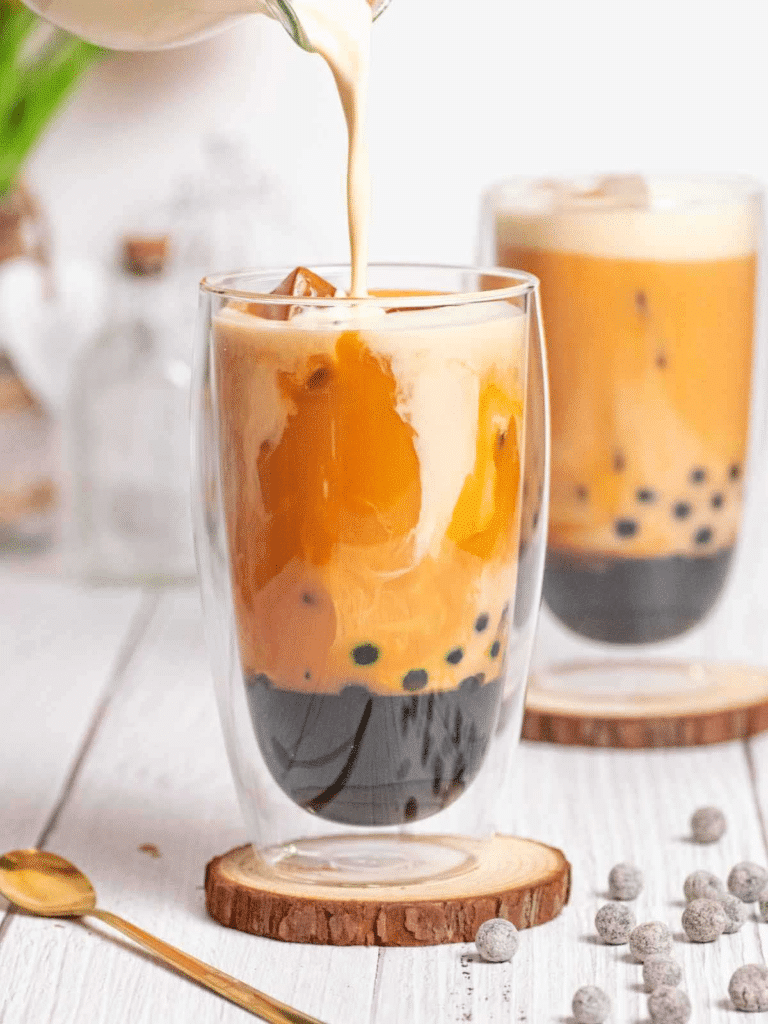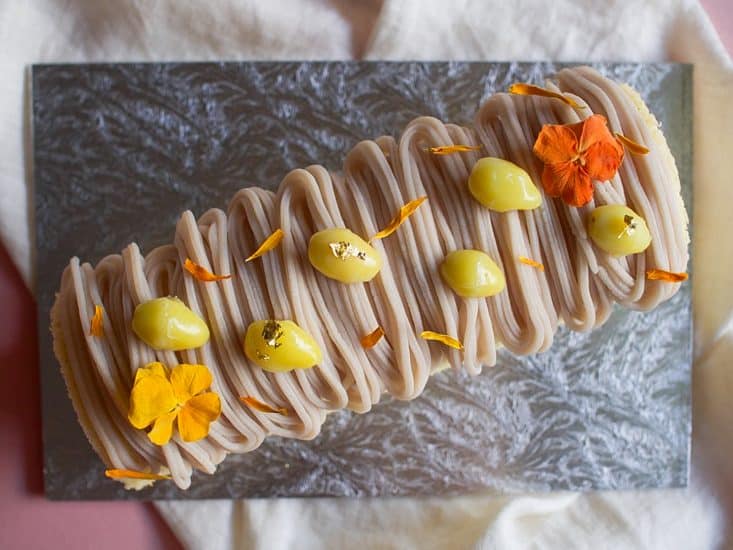Indulging The Sweet And Savory Flavors In Taro Bubble Tea
Taro bubble tea is an incredibly popular beverage, quickly becoming a fan favourite. It’s a unique blend of flavours and textures that make it stand out from other teas. If you’re curious about the taste of taro bubble tea, you’ve come to the right place!

This article will answer your questions about its flavour profile and why people love it so much. So, what does taro bubble tea taste like? Let’s dive in and find out!
Discovering Taro
Taro, also known as Colocasia esculenta, is a starchy root vegetable that has been a staple food in many parts of the world for centuries. Its origin can be traced back to Southeast Asia and India and was later introduced to Africa and the Americas by early explorers. Taro is now widely consumed across the globe for its impressive health benefits and unique taste.
Taro has a versatile flavour profile with subtle nutty notes, making it ideal for sweet and savoury dishes.
Taro Vs Ube
Taro and ube are two popular root vegetables that have gained attention for their unique taste and vibrant colour. While they may look similar, taro and ube have distinct flavour, texture, and usage differences.
Taro has a nutty and earthy flavour with a slightly sweet undertone. Its starchy texture makes it perfect for savoury dishes such as stews or as a substitute for potatoes in fries. Taro is also commonly used to make desserts such as taro milk tea or ice cream.
On the other hand, ube has a milder sweetness than taro with a hint of vanilla-like flavour. Its bright purple hue makes it an ideal ingredient for visually stunning desserts like cakes, pastries, or ice cream. Ube also contains antioxidants and nutrients such as vitamin C and potassium.
The Taste Of Taro Bubble Tea
Taro boba tea is a popular Taiwanese beverage that has gained popularity worldwide. This unique drink is made by blending taro root powder with milk, sugar and ice. The addition of chewy tapioca pearls or “boba” creates the signature bubble effect for which this drink is famous.
The taste of taro boba tea has been described as earthy and nutty with a slightly sweet aftertaste. Taro root is naturally starchy, which gives the drink its thick, creamy texture. The combination of sweetened condensed and coconut milk enhances the flavour profile even further, making it irresistible to those who have tried it.
One of the reasons why taro boba tea has become so popular globally is because it offers something different from traditional teas or coffees. It’s refreshing, delicious and fun to drink, thanks to its playful bubbles.
Nutritional Value
Taro bubble tea is a popular beverage among youth and adults alike. What sets taro bubble tea apart from other drinks are the numerous vitamins, nutrients and benefits it provides to the body.
Taro root contains high levels of fibre, which helps improve digestion and bowel movement. It is also an excellent source of potassium, which regulates blood pressure and reduces the risk of heart disease. Additionally, taro root has antioxidants that protect against cell damage caused by free radicals. These antioxidants also promote healthy skin by reducing signs of ageing.
Additionally, drinking taro bubble tea could lower your risk of developing certain diseases, such as cancer or cardiovascular disease.
However, it’s important to remember that taro bubble tea often includes sweeteners like sugar or honey, leading to excess calories that can negatively impact your health.
Ingredients
Bubble tea is a popular drink that has taken the world by storm. It originated in Taiwan and is now enjoyed all around the globe. The drink is made up of tea, milk, sugar, and some form of chewy tapioca balls or fruit jelly.
However, many variations to this recipe make it unique to each region.
Sweetener
Choosing a sweetener for your bubble tea can be daunting, especially when trying to balance taste with health. One popular flavour is taro, which has a unique nutty and vanilla-like taste that pairs perfectly with creamy milk tea. When it comes to sweeteners, there are several options available.
The first option is cane sugar. This natural sweetener is widely used in the beverage industry and provides an authentic sweetness to your taro bubble tea. While cane sugar may not be the healthiest option, it’s better than high fructose corn syrup or artificial sweeteners.
Another great alternative is honey or agave nectar, which are considered healthier options as they are less processed and contain more nutrients than regular sugar. However, remember that these sweeteners have flavours that may change the taste profile of your taro bubble tea.
Toppings
Choosing high-quality boba pearls can make or break the taste and texture of your drink. This article will discuss how to choose quality boba pearls for your taro bubble tea.
Firstly, looking at the ingredients list on the package is important. Quality boba pearls should only contain tapioca starch, water, and a natural colouring agent if necessary. Avoid products with added preservatives or artificial flavours, as they can affect the taste and quality of your drink.
Another factor to consider when selecting boba pearls is their texture. High-quality boba pearls should be soft and chewy but still, maintain their shape when cooked correctly. To ensure you get the correct consistency, follow the manufacturer’s cooking instructions carefully.
Taro Base
When selecting a taro base for your bubble tea, it’s important to consider the quality of the ingredients the manufacturer uses. Look for products made from fresh taro roots with no added artificial flavours or colours. A high-quality taro base will have a rich, natural flavour that enhances the taste of your beverage.
Another factor to consider when choosing a taro base is its consistency. Some bases may be too thick or thin, affecting your drink’s overall texture and creaminess.
Other Desserts You Can Make From Taro

Taro is a starchy root vegetable commonly used in Southeast Asian cuisine. It has a nutty and sweet flavour, which makes it an excellent ingredient for creating delectable desserts. If you want to incorporate taro into your dessert menu, here are some ideas to get you started.
One classic dessert that uses taro is the Chinese-style taro cake. This cake is made by steaming grated taro with rice flour, sugar, and coconut milk until it becomes soft and sticky. The finished product has a light purple colour and a soft texture similar to mochi.
Another popular dessert in Southeast Asia is Bubur cha-cha, which features cooked taro cubes and sweet potatoes in a coconut milk base flavoured with pandan leaves.
One classic way to use taro in desserts is to make Taro Mochi. Mochi is a Japanese rice cake that can be filled with all kinds of sweet fillings.
Conclusion
In conclusion, taro bubble tea is a unique and delicious beverage. Its sweet, creamy flavour combines perfectly with the slightly nutty taste of taro and its chewy tapioca balls. It’s an easy-to-drink treat that can be customised to fit any taste preference.
All in all, taro bubble tea is a refreshing and satisfying way to satisfy your sweet tooth. If you want something new and different, why not try this fun, flavorful drink?
FAQs
Is taro different from cassava?
Yes, taro and cassava are two different root vegetables.
Taro is a tropical plant in Southeast Asia related to the yam family. It has a starchy texture, similar to potatoes or yams, and can be boiled or steamed. Its flavour is slightly sweet and nutty.
On the other hand, cassava is native to South America and belongs to the spurge family of plants. It has an earthy taste and a crunchy texture when raw but becomes soft when cooked. Cassava can be used in many dishes, such as fries, chips, pancakes, and desserts.
Is taro different from yam?
Yes, taro and yam are two different root vegetables.
Taro is native to Southeast Asia and is a starchy tuber with rough, brown skin and white or pink flesh. It has a nutty flavour and can be boiled, fried, mashed, or baked.
Yams are native to Africa and are related to lilies and grasses. They have rough brown skin and white, yellow, or purple flesh. Yams have a sweet flavour that can be boiled, steamed, roasted, or mashed. They are often used in soups, stews, and side dishes like mashed potatoes or fries.
What is the health risk of too much taro?
Too much taro can have some negative health effects. Taro is high in oxalates, which can cause kidney stones or other kidney problems if consumed in large amounts. Additionally, taro contains calcium oxalate, which can be toxic to the body if it accumulates in the blood. This can lead to symptoms like nausea, vomiting, and abdominal pain.






